Bowing in Japan: How Much to Bow and When

The “Art of the Bowing” or Ojigi (お辞儀) in Japan is deeply rooted in Japanese culture and tradition. Bowing is a way to show respect while greeting others or apologizing to others. Unlike the Western handshake, bowing takes on many shapes, sizes, and forms.
Bowing is done for greetings, farewells, and apologies and also while praying in shrines. In short, it is prevalent in nearly all aspects of Japanese daily life. This article will discuss the bowing culture in Japan and how to bow properly in different situations.
Why Bowing?
Bowing down in front of others reflects that the person is giving up their ego. But, in an extreme sense, it also indicates that the person is at the mercy of others. It’s like offering your neck.
Bowing typically means bending down at waist level with the head tilting downwards. However, let’s first talk about tilting the head downwards.
A head nod is a universal gesture of saying “yes.” A downward tilted head carries the meaning of a head nod and indicates acceptance. An upward-tilted head displays pride, confidence, and often superiority.
On the other hand, in a negative sense, a lowered head without eye contact reflects low self-worth. However, in a positive sense, it’s about putting more worth on the person before you, reflecting respect, humility, and submissiveness. And these aspects get more profound with a complete bow while bending your body at the waist. Therefore, bowing is about acceptance, submission, and reflecting that the person in front is worthy of respect.
The depth of the bow decides whether the person is senior or not senior but worthy of respect.
When two people of equal seniority bow to each other, the angle of the bow is similar; however, in the case of different seniorities, the junior person bows deeper.
When bowing to make an apology, the person is at fault and bows more profoundly to another person. In such cases, the other person may bend slightly as a gesture of pardon or, in case of a severe mistake by others, refrain from bowing.
Bowing Culture is Not Specific to Japan
As we saw, bowing is a natural gesture; hence, it is not limited to Japan. Even in European countries, people used to bow in front of the nobility. We can still witness the slight bowing in churches, or for that matter, in temples and mosques.
However, in many Asian cultures, including Japan, bowing is still an essential part of the culture. But, the protocols of bowing differ from country to country and from religion to religion.
For example, in India, traditionally, junior people bow down to touch the feet of senior relatives. However, in many other cultures, the tradition of bowing has been getting diluted. But, in Japan, bowing is still an essential part of the tradition.
In this article, we will focus on the bowing culture of Japan, different types of bows, and bowing protocols in Japan.
The following pictures show that bowing is not specific to Japan but is a universal and natural gesture in various societies and religions.
Bowing in Churches
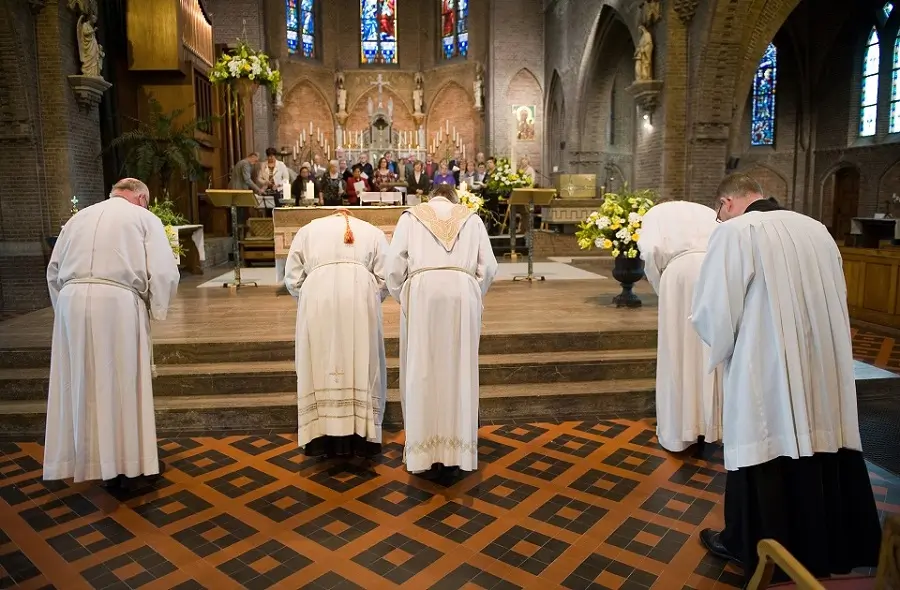

Culture of Bowing in India
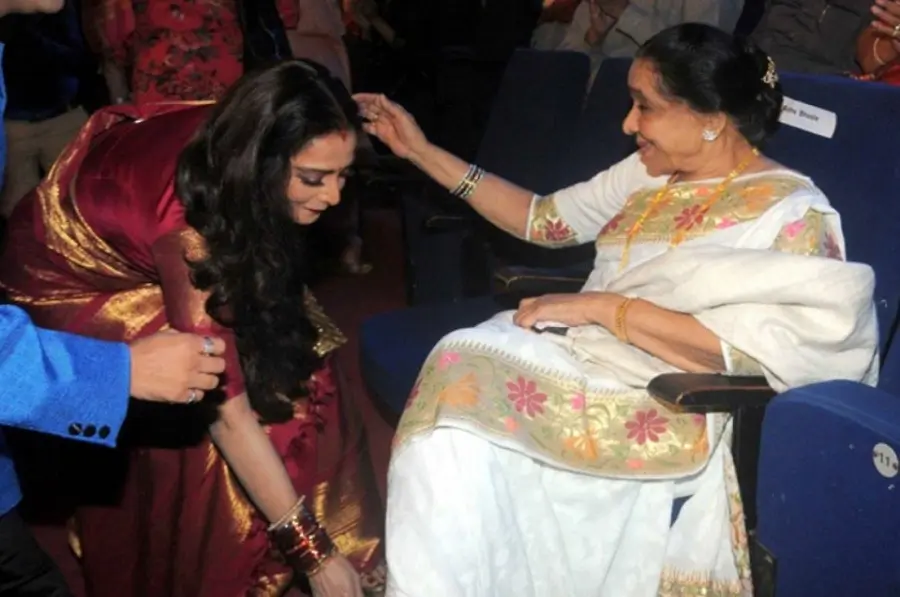

Bowing in Islamic Religion
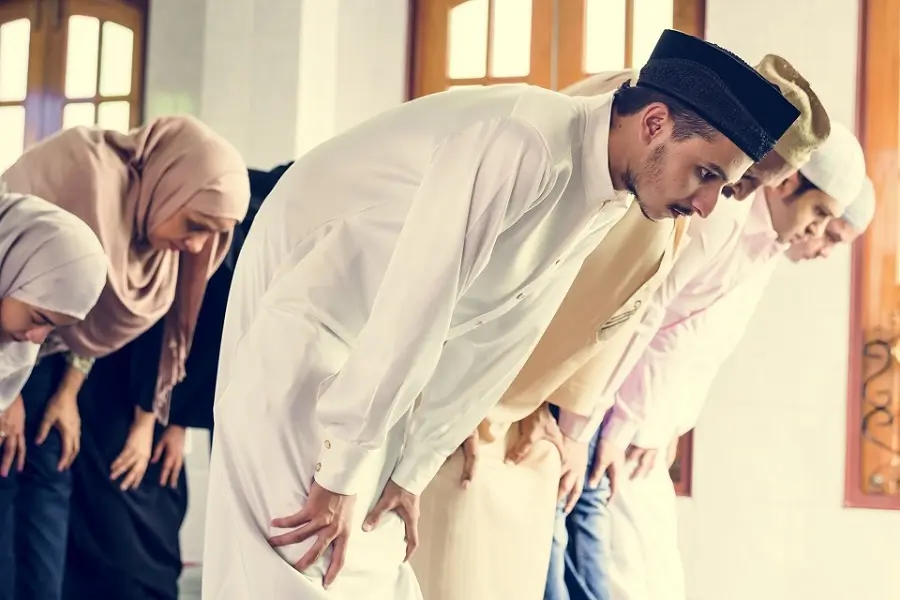

Types of Bowing in Japan and to What Degree or How Deep
While there are rules on when to bow and the depth of the bow, it depends on the situation. Generally, we can divide the bows into the following categories:
- Casual Bows
- Informal Bows
- Formal Bows
- very formal Bows
- Apologetic Bows
Casual Bows
The casual bow is simply like saying hello when you cross paths with someone you know. In such situations, it is common to make a slight bow with a head nod and say hello or “Konnichiwa” and keep walking. The casual bows do not follow strict protocols, and these are just like little nods of heads.
Informal Bowing
As the name suggests, an informal bow is with friends, family, or people who are very junior to you. People bow in such cases mainly to acknowledge others’ presence. For informal bowing, people bend by about 10 to 15 degrees. And, similar to casual bowing, there are no strict protocols for informal bowing.
Formal Bowing
Formal bows include bowing to senior people in personal life, senior colleagues at the workplace, and customers.
Formal bowing is critical in Japanese culture, and not doing it properly can create bad impressions. Formal bows occur during welcoming someone and at the beginning and end of official meetings.
The formal bows are done by bending 25 to 45 degrees. Generally, formal bowing does not occur with the colleagues you meet daily, regardless of seniority.
When meeting your colleagues for the first time or while meeting a customer, they’ll likely bow toward you, and you’ll return the gesture. They’ll probably do an eshaku (会釈) bow in this situation. For this bow, you bend to about a 15-degree angle forward.
When greeting your superiors, customers, or potential business partners, a keirei (敬礼) bow is appropriate. This bow is at a 30-degree angle and is a bit more respectful. However, bowing around a 45-degree angle is common if the other person is quite senior to you.
Very formal bows
Very formal bowing in Japan is typically done by bending more than 45 to 70 degrees. However, the very formal bowing can sometimes extend up to 90 degrees.
Such formal bowing is generally in the official setup when meeting with very senior colleagues for the first time or with business partners. Especially 90-degree bows are typical with the customers.
In Japan, when a business partner or customer visits you for a meeting, it’s a custom to accompany them to the elevator or the exit after the meeting. A very formal bow up to 90 degrees is common at this final departure point.
Apologetic Bows in Japan
The apologetic bow conveys a sense of deep regret and remorse and is done with a deeper bow held for a few seconds.
For example, if you make a serious mistake, you apologize by bowing profoundly and holding that stance for a few seconds. You can often see such apologetic bows in Japanese business or even with elders in the family. The common phrase in this situation is usually “hontoni Kokoro kara owabi itashimasu“, meaning “I sincerely apologize from the bottom of my heart.”
There are two types of apologetic bows:
- Saikeirei (最敬礼)
- Dogeza (土下座)
Saikeirei Bow
Saikeirei bows are apologetic bows when a person has made a mistake that is not very severe in nature. For a saikeirei bow the body bends at about a 45 to 90-degree angle to show remorse and guilt.
Dogeza Bow
Dogeza bow has its roots in Japanese history back to the feudal or samurai period. This act of bowing is done by kneeling on the ground with one’s head touching the floor. Japanese people do Dogeza bow in the following circumstances:
- Apology for making a big mistake and causing harm to another person
- If someone has done an extreme favor
- Asking someone for a huge favor
However, nowadays, the Dogeza bow is very rare. However, you can see the kneeling bow in the theatre and during Sumo competitions.
Bowing in Japanese Business Situation
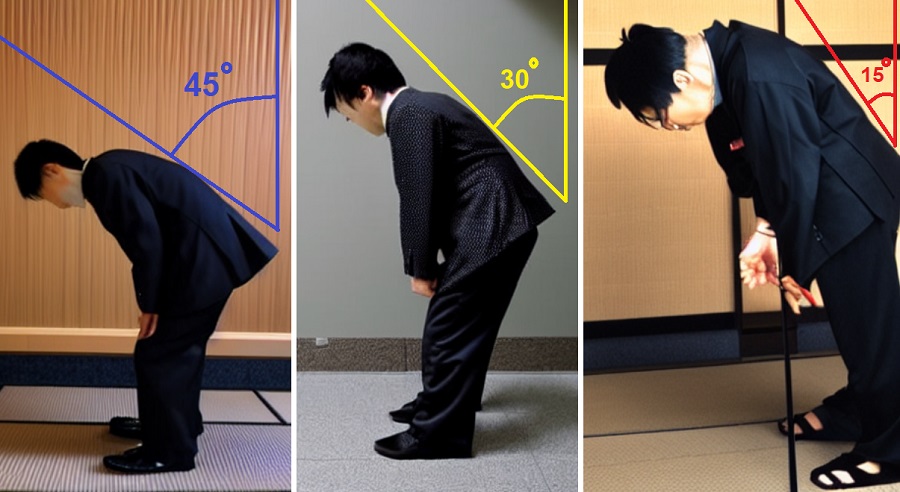

In more formal Japanese settings, such as in business, there are protocols ranging from how you speak to the style and deepness of the bow. These protocols depend on who you are addressing. For example, how you bow depends on rank or status.
While greeting or saying farewell to someone senior, people typically bow 45 degrees to 60% with their hands at their side. While bowing to customers, the bowing can be as deep as 90 degrees.
In business meetings, when you visit the business partner’s office, the first bowing is a greeting bow when you meet the people you have come to meet.
As mentioned earlier, hosts accompany the guests to the elevator or the exit when the guests are leaving. In such cases, a light bow is made before the guests enter the elevator. Once the guests enter the elevator, a deeper bow is made and held until the elevator doors are closed.
Bowing while meeting the Business Partner or Customer for the First time
During the first introductory business meetings, assuming there are multiple members from the hosts’ and guests’ sides, there are two scenarios as follows:
- Scenario 1: When you announce your arrival, which is ideally 5 minutes before the scheduled meeting time, one of the team members of your hosts meets you at the reception to take you to the meeting room, and other team members are standing and waiting inside the meeting room
- Scenario 2: One of the receptionists or someone who will not be in the meeting accompanies you to the meeting room, and the host team enters at the designated meeting time
Scenario 1:
You bow to each other at the reception without exchanging business cards. Once you enter the meeting room, both parties bow to each other.
If there are multiple members, these bows are not individual, but the bowing takes place as a group, not towards any particular individual on the opposite side. The junior people on either side will bow deeper than the senior people.
After entering the meeting room, the hosts will request the guests to sit on the opposite side of the door. The first activity will be exchanging business cards once the guests keep their bags in the designated seating.
During the card exchange, individual bowing takes place. Now, the members of both sides bow to members of the other side individually while offering the business card. The card exchange is seniority-wise in descending order. After accepting the business card, people bow again with a deeper bow before going to their seats. You can read more about business card exchange in Japan.
Scenario 2:
Once the receptionist or a representative who will not be part of the meeting directs you to your seating area, you will take your seats and wait for the hosts to enter. Once the hosts enter, you stand up and bow before exchanging cards and bowing exactly as in scenario ‘1’ above.
Bowing in Daily Japanese Life
In everyday life, you will see different styles of bowing. You will likely be greeted in stores or restaurants with a welcome, which is “Irasshaimase” in Japanese.
In department stores, aboard airplanes, or on the Shinkansen (bullet train), staff will bow with a soft voice greeting, and hands usually crossed. Normal service greetings of this type take on this form of bowing.
Even when staff is changing shifts and about to clock out, they offer this greeting even when not particularly addressing one specific individual. I see this in department stores all the time and realize just how polite a country Japan really is!
Bowing and Eye Contact
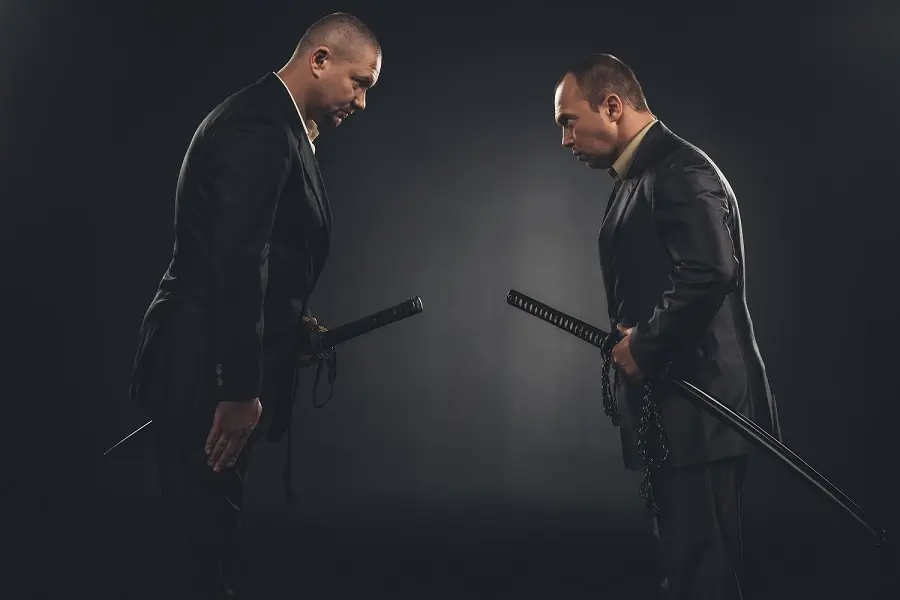

As a show of respect, you do not make eye contact while bowing to another person or group. However, an exception to this rule is the fighting competitions like martial arts. Therefore, it’s very logical that while you show respect, you do not lose eye contact with your opponent while bowing during such times.
Position of Hands
There are some differences in the hand position if you are a man or a woman.
For men, when bowing, arms are extended with the palm of your hands touching the side of your legs—bow from the waist, typically 30 degrees for 2 seconds.
For women, elbows are slightly bent with hands in front of the body, left palm over the back of the right hand.
When sitting — at the start of a business meeting or dinner, the hands are on your thighs, and sit up straight. Look straight ahead, avoid direct eye contact, and don’t fidget. When in doubt, take cues from more experienced people on what to do and the next steps.
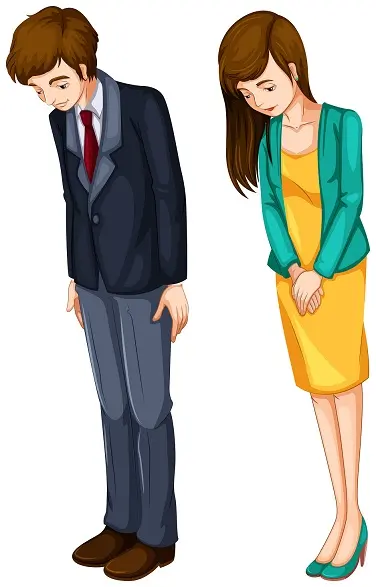

Embrace the Culture of Bowing to Integrate Better
In short, the Japanese bow is a ritual deeply rooted in history, culture, and tradition. Bowing in Japan is especially important when greeting senior colleagues at formal meetings and business dinners with customers.
Japanese culture of bowing is another example of the unspoken communication style prevalent in Japanese society. Therefore, mastering the art of bowing is vital if living or working in Japan.
Mastering the art of bowing is essential in Japan, especially in business, as it reflects a person’s attitude and character. If done casually, it is usually seen that a person does not care and is likely sloppy doing the job, so it should be taken seriously.
With experience, one will realize the importance of bowing and understand this unspoken form of communication and its role in forging relationships.
As a foreigner in Japan, it is embarrassing to forget to bow or shake hands with a slight bow; however, Japanese people will generally shrug it off with a laugh. So again, there is not much risk of it being offensive or rude.
However, in business, ceremonies at Japanese temples or shrines are formal and involve a ritual, so it is best to respect the bowing rules. Therefore, it is vital to display proper bowing etiquette in these situations.
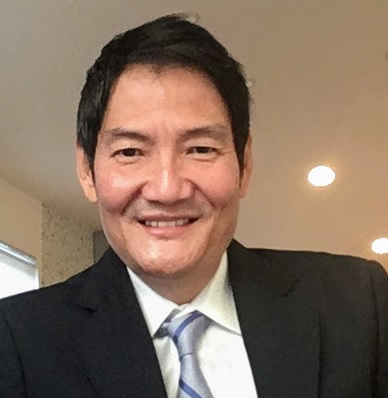

Native Japanese raised in the USA, Yoshinobu Takaoka returned to Japan 20 years back and is a senior finance professional with over 20 years of working experience in Japan. While being Japanese, Yoshinobu has a deep understanding of Japan and Japanese customs, growing up in the U.S. he also has a deep understanding of western culture and what makes foreigners curious about Japan.

